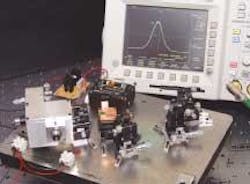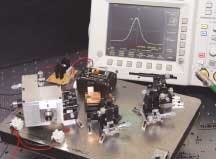Femtosecond source runs on batteries
A research team at the University of St. Andrews, Scotland, has developed a battery-powered, diode-pumped portable femtosecond laser that is small enough to fit onto a 22 ¥ 28 cm2 breadboard. Because of its size and relatively low cost, the system has the potential to open up new applications for femtosecond lasers.
A key factor in the development of this compact and efficient laser is minimization of the lasing threshold. Several design features work toward this attainment. The number of elements in the laser cavity is kept to a minimum, comprising a low-loss semiconductor saturable absorber mirror as the modelocking element, a chromium-doped lithium strontium aluminum fluoride (Cr:LiSAF) laser crystal, an output coupler, and dichroic high-reflecting fold mirrors.
The dispersion compensation is provided by the fold mirrors that exhibit negative group delay. The low pump-power threshold of Cr:LiSAF allows it to be pumped with low-cost narrow-stripe diode lasers. Although relatively low in power compared with broad-stripe versions, the diffraction-limited output of these diodes means that extensive pump optics are not needed—another advantage when building compact systems.
The broad absorption band of the crystal allows two different pump wavelengths can be used. This, in turn, means that the coupling of the two pump beams can be made without the significant losses incurred in standard polarization coupling for beams of the same wavelength. And so, in the new system, two narrow-stripe gallium indium phosphide/aluminum gallium indium phosphide diode lasers, one emitting at 660 nm and the other at 685 nm, pump the 3-mm Cr:LiSAF crystal in a Z-cavity arrangement.
Performance of the laser is good by any standards. It is efficient—the simple, low-loss design means that the system operates with an electrical-optical efficiency of 4%, which the St. Andrews' team claims is the highest reported efficiency for any femtosecond laser. Average output powers of up to 20 mW have been achieved for 95 mW of incident pump power, giving an optical-optical efficiency of 21%. The output is in transform-limited pulses 136 fs long, centered at an 859-nm wavelength, and with a repetition rate of 470 MHz.
The laser appears to be very stable—the output power was measured to have fluctuations of less than 1% for periods of more than an hour. These measurements were made on a laser that was not enclosed and located in a lab that was not temperature-controlled. The group expects that, in a more enclosed and controlled local environment, the amplitude fluctuations would be extremely small.
'Wallplug efficiency' passé here
The ultracompact version of the laser uses the same design and was built using small-scale optomechanical components (see figure). This laser is powered by six AA penlight batteries, providing an electrical drive power of less than 1 W. The batteries enable the laser to be run modelocked for more than 12 h. The entire laser system—including the pump stage, power source, and drive electronics—fits on a 22 ¥ 28 cm2 breadboard. Initial results have demonstrated pulses from this portable system of 130-fs duration at an average output power of 14 mW. Variations on the basic design also have been tried. By pumping with two pairs of diode lasers, both kilowatt output power and gigahertz repetition rate have been achieved, opening up new potential application areas.
"We've produced 122-fs pulses with 1.2-kW peak power and 35-mW average power, and also 3-mW output power at a 1-GHz repetition rate," said Ben Agate, a member of the St. Andrews team. "We believe that our system has the potential to open up femtosecond laser applications that have so far been hindered by the large size and high cost of its predecessors. It could be used as a compact source for generating broad continuum light in photonic crystal fibers, and as an efficient source of ultrashort pulses in the blue region. We have already built a system operating in the blue and we are working on ways to improve wavelength tunability."

